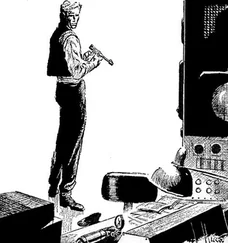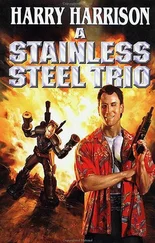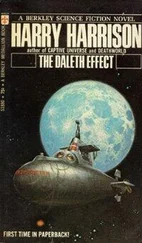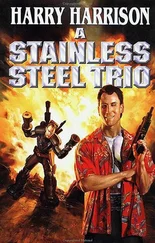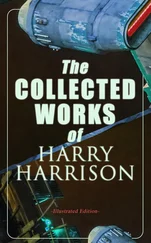Harry Harrison - The Turing Option
Здесь есть возможность читать онлайн «Harry Harrison - The Turing Option» весь текст электронной книги совершенно бесплатно (целиком полную версию без сокращений). В некоторых случаях можно слушать аудио, скачать через торрент в формате fb2 и присутствует краткое содержание. Год выпуска: 1992, ISBN: 1992, Издательство: Viking, Жанр: Фантастика и фэнтези, на английском языке. Описание произведения, (предисловие) а так же отзывы посетителей доступны на портале библиотеки ЛибКат.
- Название:The Turing Option
- Автор:
- Издательство:Viking
- Жанр:
- Год:1992
- ISBN:978-0-670-84528-6
- Рейтинг книги:3 / 5. Голосов: 1
-
Избранное:Добавить в избранное
- Отзывы:
-
Ваша оценка:
- 60
- 1
- 2
- 3
- 4
- 5
The Turing Option: краткое содержание, описание и аннотация
Предлагаем к чтению аннотацию, описание, краткое содержание или предисловие (зависит от того, что написал сам автор книги «The Turing Option»). Если вы не нашли необходимую информацию о книге — напишите в комментариях, мы постараемся отыскать её.
The Turing Option — читать онлайн бесплатно полную книгу (весь текст) целиком
Ниже представлен текст книги, разбитый по страницам. Система сохранения места последней прочитанной страницы, позволяет с удобством читать онлайн бесплатно книгу «The Turing Option», без необходимости каждый раз заново искать на чём Вы остановились. Поставьте закладку, и сможете в любой момент перейти на страницу, на которой закончили чтение.
Интервал:
Закладка:
“Isn’t that part of the connection between the two halves of the brain?”
“It is — and it was a serious, and possibly dangerous, decision. But I had no choice. So at this time the patient is really two half-brained individuals. Were he conscious this would be a disaster. But, having severed the corpus callosum cleanly, I hope to be able to reconnect the two halves completely. Tell me — what do you know about the human brain?”
“Very little — and all probably out of date since my undergraduate days.”
“Then you are completely out of date. We are at the threshold of a new era, when we will be able to call ourselves mind surgeons as well as brain surgeons. Mind is the function of the brain and we are discovering how it operates.”
“Specifically, then, in Brian’s case, how serious is the damage — and is it repairable?”
“Look here, at these earlier V.I. images, and you will see.” She pointed to the colored holograms that apparently floated in midair. The three-dimensional effect was startling — as though he was looking inside the skull itself. Snaresbrook touched a white patch, then another. “This is where the bullet went into the skull. It exited here, on the right. It passed through the cortex of the brain from side to side. The good news is that the cerebral cortex of the brain seems mostly intact, as are the central organs of the middle brain. The amygdala here appears to be undamaged, as well as most important of all, the hippocampus, this roughly seahorse-shaped organ. This is one of the most critical agencies involved in forming memories, and retrieving them. It is the powerhouse of the mind — and it wasn’t touched.”
“That’s the good news. And the bad—”
“There is some cortical damage, though not enough to be very grave. But the bullet severed a large number of bundles of nerve fibers, the white matter that makes up the largest portion of the brain. These serve to interconnect different parts of the cortex to one another — and also to connect them to other midbrain organs. This means that parts of Brian’s brain are disconnected from the data bases and other resources that they need for performing their functions. Therefore at this moment Brian has no memories at all.”
“You mean his memory is gone, destroyed?”
“No, not exactly. Look — the largest parts of his neocortex are still intact. But most of their connections are broken — see here, and here. To the rest of the brain they do not exist. The structures, the nerve connections that constitute his memories are still there — in various sections of his shattered brain. But they can’t be reached by the other parts, so they are meaningless by themselves. Like a box full of memory disks without a computer. This is a disaster since we are our memories. Now Brian is essentially mindless.”
“Then he is a… vegetable.”
“Yes — in the sense that he cannot think. You might say mat his memories have been largely disconnected from his brain computers, so that they cannot be retrieved or used. He cannot recognize things or words, faces, friends, anything. In short, so far as I can see, he no longer can think to any degree. Consider this. Other than size, one could say that there is little observable difference between most of the brain of a man and a mouse — except for those magnificent structures of our higher brain — the neocortex that evolved in the ancestors of the primates. In this present state, poor Brian, my friend and my collaborator, is little more than a selfless shell, a submammalian animal.”
“Is that it? The end?”
“No, not necessarily. Although Brian cannot actually think, he is definitely not brain-dead as the lawyers put it. A few years ago nothing more could have been done. This is no longer true. I am sure that you know that Brian has helped me in a practical application of his AI theories, the development of an experimental technique to rebuild severed brain connections. I have had a measure of success, but only on animals so far.”
“If there is a chance, any chance at all, you must take it. Can you do it, can you save Brian?”
“It is too early to say anything with any degree of certainty. The damage is extensive and I don’t know how much I can repair. The trouble is that in addition to the general trauma the bullet has severed millions of nerve fibers. It will be impossible for me to match up all of them. But I hope to identify a few hundred thousand and join them.’’
Benicoff shook his head. “You just lost me, doctor. You are going into his open skull and identify something like a million different and severed nerve fibers? That will take years.”
“It would if I had to do them one by one. However, computer-controlled microsurgical technology can now operate on many sites at one time. Our parallel computer can identify several connections every second — and there are 86,400 seconds in each day. If everything goes as planned the memory-probe process should only take a few days to identify and label the nerve fibers we must reconnect.”
“Can this be done?”
“Not easily. When a nerve fiber is cut off from its mother cell it dies. It is fortunate that the empty tube of the dead cell remains in place and this makes regrowth of the nerve possible. I will be using implants of my own design that will control that regrowth.” Snaresbrook sighed. “And after that, well, I fear that the nerve repair will just be the beginning. It is not simply a matter of connecting up all the severed nerves we can see.”
“Why is that not enough?”
“Because we must restore the original connections. And the problem is that all nerve fibers look, and are, almost the same. Indistinguishable. But we have to match them up correctly to get the right connections inside the mind. Memory, you see, is neither in the brain cells nor in the nerve fibers. It is mostly in the layout of the connections between them. To get things right, we shall need a third stage — after we’ve finished the second stage today. After that, we shall have to find a way to access and examine his levels of memory — and rearrange the new connections accordingly. This has never been done before and I am not sure that I can do it now. Ah, here we are.”
The technician hurried in with the multiscan cassette of the V.I. and inserted it into the projector; the three-dimensional hologram sprang into existence. Snaresbrook examined it closely, nodded grimly. “Now that I can see the extent of the damage, I can finish the debridement and prepare for the second and vital stage of this operation — the reconnection.”
“Just what is it you plan to do?”
“I’m going to use some new techniques. I hope to be able to identify the role that each of his nerve fibers once played in his various mental activities — by finding out where each of them fit into his semantic neural networks. These are the webs of brain connections that make up our knowledge and mental processes. I must also take the radical step of severing the remaining portions of his corpus callosum. This will provide the unique opportunity of making connections to virtually every part of his cerebral cortex. This will be dangerous — but will provide the best chance to reconnect the two halves completely.”
“I must know more about this,” Benicoff said. “Is there any chance you will let me observe the operation?”
“Every chance in the world — I have had up to five residents in the O.R. breathing down my neck at one time. It’s fine with me as long as you stay out of my way. What’s this sudden interest?”
“More than morbid curiosity, I assure you. You’ve described the machines you use and what they do. I want to see them in operation. I need to know more about them if I am going to ever know anything about AI.”
Читать дальшеИнтервал:
Закладка:
Похожие книги на «The Turing Option»
Представляем Вашему вниманию похожие книги на «The Turing Option» списком для выбора. Мы отобрали схожую по названию и смыслу литературу в надежде предоставить читателям больше вариантов отыскать новые, интересные, ещё непрочитанные произведения.
Обсуждение, отзывы о книге «The Turing Option» и просто собственные мнения читателей. Оставьте ваши комментарии, напишите, что Вы думаете о произведении, его смысле или главных героях. Укажите что конкретно понравилось, а что нет, и почему Вы так считаете.

